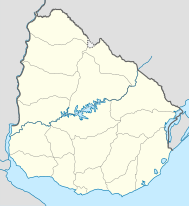Vergara (Uruguay)
| Vergara | ||
|---|---|---|
|
Coordinates: 32 ° 57 ′ S , 53 ° 56 ′ W Vergara on the map of Uruguay
|
||
| Basic data | ||
| Country | Uruguay | |
| Department | Treinta y Tres | |
| City foundation | March 10, 1903 by José Fernández Vergara | |
| Residents | 3810 (2011) | |
| Detailed data | ||
| height | 16 m | |
| City Presidency | Maria del Carmen Muniz Cuello | |
| Website | ||
Vergara is a city in Uruguay .
geography
The city, also known as "Capital del arroz" (German: Capital of rice) is called, is located in the area of the Departamento Treinta y Tres about 58 kilometers northeast of the homonymous department capital with which they have the Ruta 18 is connected . Vergara lies on the banks of the Arroyo Parao , on the northern edge of the city the Arroyo de las Islas flows into it. Larger settlements in the vicinity are Mendizábal in the southwest, Estación Rincón in the northeast and Arrozal Treinta y Tres in the southeast.
history
Most of the surrounding lands belonged in the 19th century to Luisa Ignacia Saravia and Enrique Da Rosa , who transferred their property to the Brazilian citizen José Fernández Vergara (born December 25, 1841 in Cangussu , Rio Grande) on December 20, 1877 and February 18, 1887, respectively do Sul, Brazil), to which the city was founded. Vergara's founding process, which began in 1890, when the foundation stone was laid for the church, was completed on March 10, 1903 by Law No. 2788. Even before this official founding, settlers from Italy in particular came in the last decade of the 19th century, but also those from various other European countries who settled there. In 1901, Escuela Nº 17 was the first official school and in the following years the educational offer on site was expanded. However, even before this point in time, an unofficial basic school supply was guaranteed by the city founder and some influential residents. In 1912, Dr. Pedro Sala also settled the first doctor in Vergara, who was followed by a second in the following year with the doctor Santiago D. Preve . The completion of the bridge over the Arroyo Parao in 1914 was an important step in Vergara's development.
Infrastructure
The city has a junta local , a police station, a church, a small football stadium as well as the radio station AM 1210 EL LIBERTADOR and the two stations 103.3 Vergara FM and 99.7 Activa FM . Rice cultivation and livestock farming are the main sources of income for the population of Vergara. Three rice dryers are located here. In addition to the Club Uruguay , branches of the post office and the Banco Republica , various shops are located. Various equestrian-related events take place in the area throughout the year. The most important of these is the three-day Coco Cuadrado held annually on the first weekend in July .
education
With the Liceo Vergara "Dr. Braulio Lago" founded in 1958, Vergara has a secondary school ( Liceo ). The Escuela N ° 50 Romulo Gallego and another school are also on site. There is also an agricultural school thematically linked to rice cultivation, an INAU children's home and a municipal library that also houses a museum.
traffic
The traffic infrastructure developed by the Ruta 18, Vergara also has a connection to the AFE rail network for goods traffic
Residents
Vergara had 3,810 inhabitants at the census in 211, of which 1,936 were men and 1,874 were women.
| year | Residents |
|---|---|
| 1963 | 2,837 |
| 1975 | 2,826 |
| 1985 | 3,379 |
| 1996 | 3,983 |
| 2004 | 3,986 |
| 2011 | 3.810 |
Source: Instituto Nacional de Estadística de Uruguay
City administration
Mayoress ( Alcalde ) of Vergara is Maria del Carmen Muniz Cuello .
sons and daughters of the town
- Glauco Segovia (1927–1986), politician
Web links
- Vergara Internet portal (Spanish), accessed March 2, 2012
- Vergara Internet portal
- Vergara city map
Individual evidence
- ↑ Historia - El Pueblo del Parao (Spanish) on the Vergara Internet portal, accessed on March 2, 2012
- ↑ Liceos del Uruguay (Spanish) (PDF; 7.3 MB), accessed on February 29, 2012
- ↑ Statistical data from the Instituto Nacional de Estadística de Uruguay , accessed on September 23, 2012
- ↑ Statistical data of the Instituto Nacional de Estadística de Uruguay 1963–1996 (DOC; 75 kB)
- ↑ Statistical data from the Instituto Nacional de Estadística de Uruguay 2004 as XLS file
- ↑ "MUNICIPIOS DE URUGUAY" on the website of the Uruguayan Congress of Directors ( Memento of March 8, 2012 in the Internet Archive )

